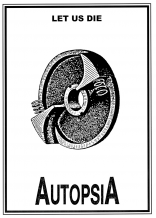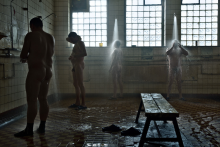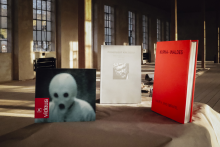| Umělec magazine 2003/1 >> Venice Over Absolut | List of all editions. | ||||||||||||
|
|||||||||||||
Venice Over AbsolutUmělec magazine 2003/101.01.2003 Pavel Vančát | venice biennale | en cs |
|||||||||||||
|
I would like to add my two bits to the maelstrom of reports storming out of this year’s Biennale, personal and touristy, bobbing on the waves of the long steamy afternoons, like a wobbly gondola on a Venetian waterway. Under the helpful patronage of the company Absolut, the two-and-a-half-day stay I enjoyed in Venice allowed me to experience not only the services of the airline Alitalia and the comforts of a five-star hotel, but also Venetian Saturday Night Fever, when a day before departure one wonders how much was missed, not understood and, most of all, sweated out. Truly hard work.
Absolut Venice: the economics of the mimetic The producer of Swedish vodka has struggled for years to create the impression in the eyes of its customers that it hunches at the center of contemporary art activities. Absolut Warhol, Absolut Saudek, Absolut Pepper, the wide selection often gives the impression of a murky dramaturgy. This year’s project, Absolut Generations, presenting 12 pairs and one trio of artists, attempted to bring it all together and, more than anything, promote it. From every country one creator from the older generation chose a younger colleague (Rosemarie Trockel chose two). In the case of all the artists of the older generation there were well-known names at the top with Louise Bourgeois, closely followed, for example, by Oleg Kulik, Wim Delvoy, and Trockel. From the younger generation I was especially taken by Béatric Cussol, French creator of ecstatic images melted into absurd aquarelles. (“If a girl cuts someone else’s hand in one of my paintings it’s not so bad because at least it’s a form of communication. It is important to find different ways of communication.”) This all presented under the influence of cocktails with intoxicating names and punch, which resulted in one of my more joyful Venetian experiences, the consequences of which very much complicated the majority of the following day. But enough fun, back to the art. The key problem of the whole exhibition was, in my opinion, not the weak cast, but the majority of the iconicity of the entire undertaking, gouging into excessive decorativeness and literalness. Despite the fact that in the exposition there were many free works, Absolut Art by individual participants attracted the most attention and was the biggest disappointment. The renaissance idea of patronage, which can only with much difficulty escape the claws of the simple mimetic, often confuses art with design. From the view point of the Czech republic, the resulting pair of Jan Saudek — Veronika Bromová is disparate, if we omit the emphasis on corporeality and provocation. Bromová, who is already known in Venice, participated with a remake of her older work Ja (Me, 1997), with the addition of two bottles of the respective drink to which she dripped in colorful accents representing the eternal counterparts of sun energy and human blood. “In the end, I think everything has the same value whether it’s ABSOLUT or the human body or a carpet or video camera. Everything is a thing, and the world is made up of lots of things,” adds Bromová. Hard to argue. Somewhat more interesting were her large-format photos, freely responding to the “homey” character of Saudek’s photos, as well as the inland closeness of Czech art. Veronika Bromová should be also credited with being the only artist to extend the concept of the exhibition to one more generation, as she invited her students from Prague Academy, Jana Doubková and Silvie Málová, to the Czech exposition with their frisky video A1 Analysis. It is an undeniable fact that, in the words of the organizers, the exhibition Absolut Generation was the first exhibition organized by a private company to be inserted into the official program of the Biennale. This is certainly a model worth following. If the artists are considered the originators, or at least the mediators, of programs, visions and ideas, their connection with economically successful brands is understandable, even, for example, for good old Mattoni. It is possible that in time we will all move away from the gallery system and into corporate art operation (or rather its legitimization). Globalization and air conditioning In the same way that Venice was a center for the importation of exotic commodities, it is now at the beginning of the new millenium a place for the importation of new ideas from regions distant from each other. Judging from the sheer volume and significance of the individual expositions, the integration of countries outside the Euro-Atlantic art circles is obviously growing at a constant rate. The fact that one is able to watch how the tradition of classic art is being mirrored is always one of the most interesting aspects of every such contemporary “world” show. Since the time of the formal inspiration of the cubist era, the art in our waters has moved in its own direction, reflecting not only the civilization itself but mostly its “superstructure” (see Marx). Those who do not own the means or the ideas belonging to them are left either to show highly individual works and their high individuality, or towards a poignant imitation of what slowly starts to flood even their own lands. And it is in this mirror that we find possible answers to the eternal question: “(What) is art (today)?” Perhaps the most successful expression of this ambivalent relationship was the concept of Wong Hoy Cheong, presented in the exhibition Zone of Urgency in Arsenal. It showed the fictitious TV document and web pages about the two hundred years of domination of the Malaysian king over the countries of the Alps. A thorough and extremely witty persiflage, presented in the decoration of a Vienna living room Besides the usual overflow of art that without the catalog in hand (weighing about two bricks) the absolute majority blends into one long series of interesting but unsurprising ideas and approaches. Venice in the middle of June was so unbearably hot, as I had never experienced as an art critic. Without a cool glass of Proseco now and then and a frequent rest in the shade, it was simply impossible to exist outside the air conditioned spaces. If many participating artists dealt with the issue of the question: “Can art kill?” Then in Venice, in the middle of June, when you sweat your sheets at midnight, I tell you, it certainly can.
01.01.2003
Recommended articles
|
|||||||||||||
|
04.02.2020 10:17
Letošní 50. ročník Art Basel přilákal celkem 93 000 návštěvníků a sběratelů z 80 zemí světa. 290 prémiových galerií představilo umělecká díla od počátku 20. století až po současnost. Hlavní sektor přehlídky, tradičně v prvním patře výstavního prostoru, představil 232 předních galerií z celého světa nabízející umění nejvyšší kvality. Veletrh ukázal vzestupný trend prodeje prostřednictvím galerií jak soukromým sbírkám, tak i institucím. Kromě hlavního veletrhu stály za návštěvu i ty přidružené: Volta, Liste a Photo Basel, k tomu doprovodné programy a výstavy v místních institucích, které kvalitou daleko přesahují hranice města tj. Kunsthalle Basel, Kunstmuseum, Tinguely muzeum nebo Fondation Beyeler.
|

































 New book by I.M.Jirous in English at our online bookshop.
New book by I.M.Jirous in English at our online bookshop.
Comments
There are currently no comments.Add new comment